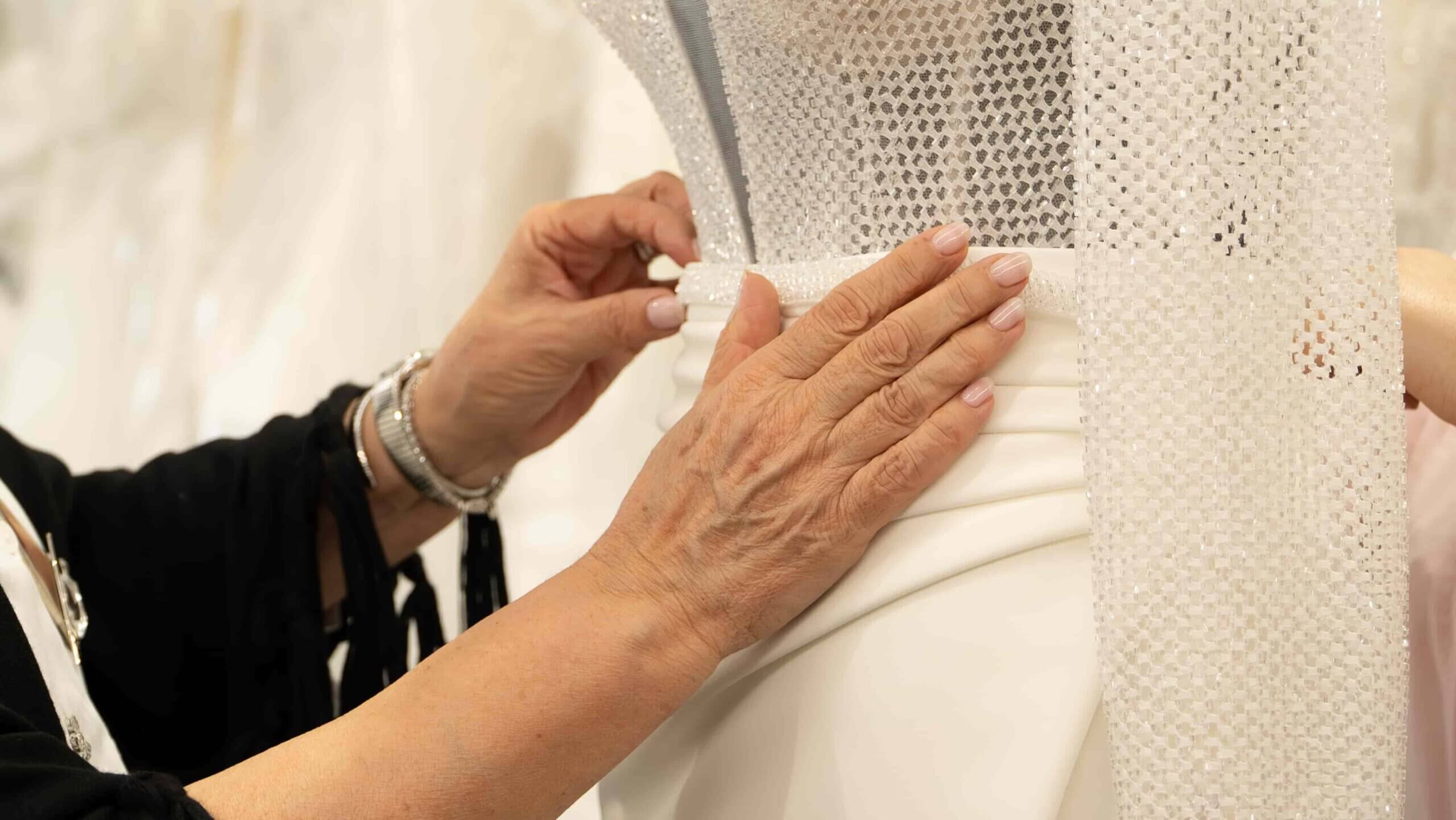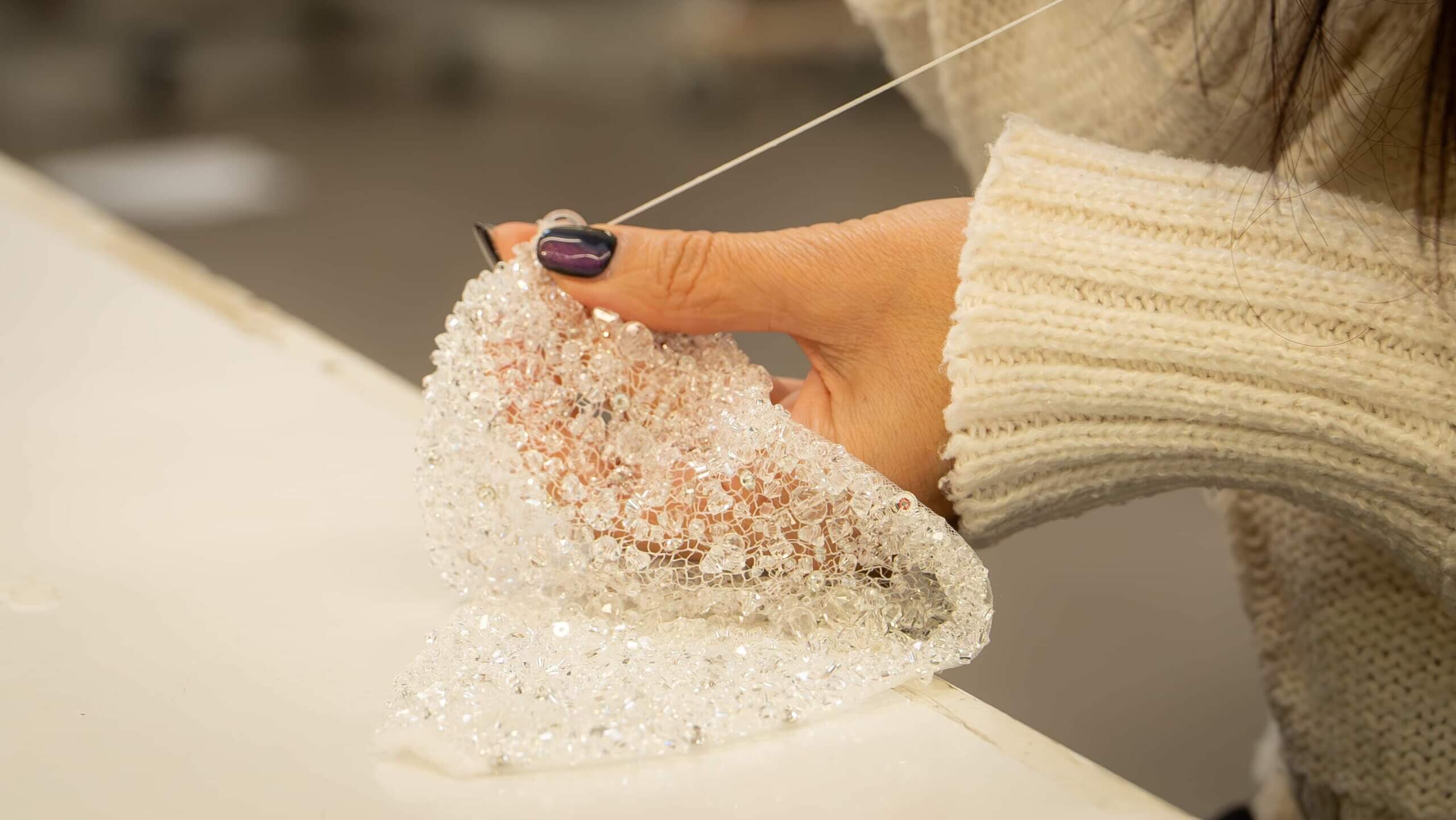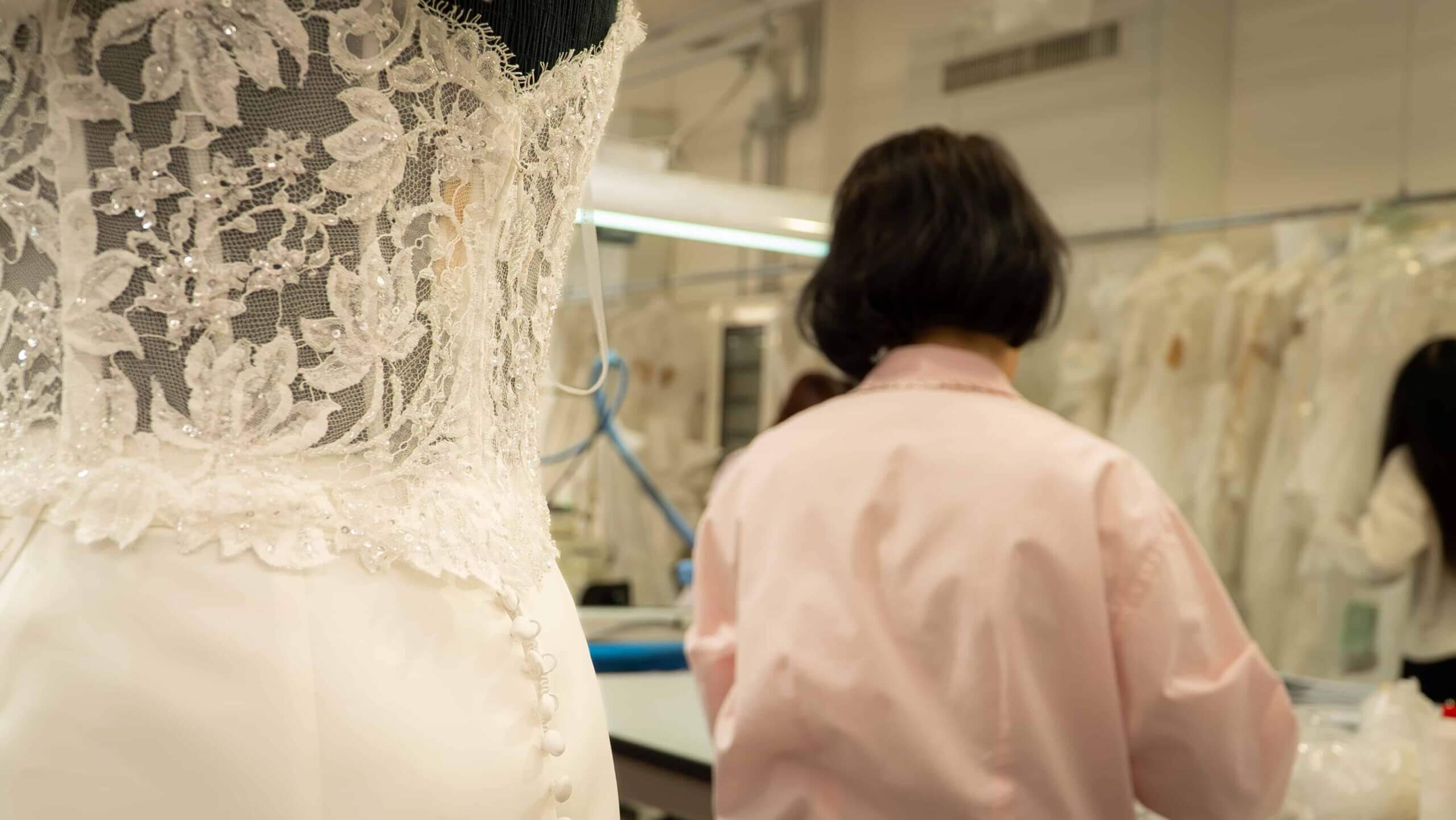
06 Mar The art of creation: the stages of crafting Luisa Sposa dresses
The realization of a wedding dress by Luisa Sposa is a craftsmanship process that reflects art, passion, and detail. Through ten distinct stages, each dress becomes a tangible testament to the craftsmanship and care that Luisa Lotti, the founder of the brand, instills in every masterpiece.
These stages represent a creative journey that begins with pure creativity and traverses various stages of meticulous manual work until the final dress check seals the finished garment. Each phase is a fundamental chapter in the dress’s narrative, incorporating the essence and values of Luisa Sposa.
- Creativity
- Design
- Cutting
- Preparation
- Assembly
- Finishing
- Embroidery
- First check
- Composition
- Final check
From Idea to Form: Creativity, Design, and Cutting
The creative phase is the beating heart of the process. Here, Luisa and her team work on the mannequin, draping lace and fabrics, letting creativity and imagination shape the dress. In the creative phase, art meets imagination, and the sources of inspiration are as varied as they are meaningful.
Every fabric, lace, or embroidery selected carries a story, an essence that Luisa Lotti and her team know how to weave into each dress. Inspiration can come from a landscape, a work of art, a literary plot, or even an emotional moment, transforming into a source from which to draw to bring unique creations to life.
In her creative space, Luisa Lotti and her team dedicate attention and care to exploring different compositions, skillfully positioning lace and fabrics on the mannequin. It is a delicate balance, where artistic vision blends with material reality. The selection of materials, harmonization of colors, and arrangement of embroideries are guided by an aesthetic intuition that seeks to capture not only the outward appearance of the dress but also the aura and personality of the future bride. This phase is a magical moment where every idea begins to take shape, slowly transforming into a masterpiece that reflects the passion and excellence of Luisa Sposa.
After the initial inspiration, the design and pattern creation phase is essential in the process of creating Luisa Sposa dresses. At this stage, the abstract idea transforms into a detailed sketch, providing a tangible first look at the future creation. Here, Luisa Lotti and her team focus on the meticulous construction of the pattern, drawing lines and shapes that will define the look and structure of the dress.
It is a process that is both technical and creative, where every line drawn on the pattern contributes to shaping the silhouette and unique details that characterize the final dress. This phase not only establishes the aesthetic foundations of the dress but is also the moment when decisions are made regarding the materials, fabrics, and sewing techniques that will be used in its creation.
During the cutting phase, the pattern physically takes shape. The selected fabrics are carefully cut following the design, beginning to give life to the dress. In the cutting phase, the artisan’s skills emerge crucially. It is not just about following a pattern, but interpreting it, working the fabric with a deep understanding of its properties and how it will fall and move on the body.
The artisan at this stage must possess an expert eye for proportions and skill in adapting the pattern to the specific needs of each bride. Every cut is deliberate and precise, executed with care and attention, as a simple mistake could alter the entire flow of the dress. This phase therefore requires not only technical competence but also artistic intuition and tailoring sensitivity that are essential for creating wedding dresses that embody elegance and perfection.

Central Stages in Dress Production: Preparation, Assembly, Finishing, and Embroidery
In the preparation phase, dress components such as the bodice are prepared and interlined, ready to be assembled. This stage requires precision and attention to detail, being fundamental to the dress’s structure. Each dress may include a unique combination of numerous tailoring elements that are carefully chosen to fit the theme, location, and personality of the bride.
A Luisa Sposa dress is composed of various elements that make it unique and extraordinary. The bodice, which constitutes the upper part of the dress, varies in style, cut, and decorations. The skirt, the elegant lower part, can take on different shapes, such as trapeze, mermaid, or enriched with a romantic long train. Sleeves, an optional element, can be long, short, three-quarter, or absent, to fit the bride’s taste and comfort. The train, an elegant extension of the skirt, varies in length and adds a touch of grandeur to the dress. The veil or veil, traditional or modern, completes the ensemble with various lengths. The belt or bodice, used to emphasize the waist, is often embellished with decorations. Embroidery and appliques, including lace, beads, and sequins, are decorative details that add character to the dress. Finally, the lining, an inner fabric, is essential for the structure and comfort of the dress.
The petticoat or crinoline is used to give volume and shape to the skirt, creating a majestic and classy effect. The bustier or integrated bra offers support and definition to the bust, ensuring impeccable fit. Shaping panels are strategic inserts that refine the silhouette, while closures, such as buttons, zippers, or corset lacing, combine functionality and aesthetics, accentuating the beauty of the dress.
Cover-ups or boleros add a touch of elegance and are particularly suitable for ceremonies in places of worship or cooler climates. Finally, the decorative belt or sash is an element that not only emphasizes the waist but also adds a distinctive detail to the entire dress.
During the assembly phase, the prepared components of the dress are carefully joined to create the final structure. Artisan skill is expressed in the precise positioning of each element, ensuring a harmonious and well-balanced result. Subsequently, in the finishing phase, every detail is meticulously cared for, from invisible stitches to perfectly aligned hems.
These are processing phases that require skilled hands and great attention to detail to ensure that the dress reaches an impeccable quality standard. Finally, in the embroidery phase, decorative elements are skillfully added, enriching the dress with refined and sophisticated details. Every stitch and every decoration is executed with millimeter precision, giving the dress timeless elegance and unique charm.
First Check: Verifying and Adjusting the Wedding Dress
After assembly, the dress undergoes a first check on the mannequin. It is time to check the size, adjust the fit, and ensure that every element is perfectly harmonious, resting the dress on the mannequin, adjusting the size, and completing the work with lace elements.
The first check of the wedding dress represents a crucial phase in the craftsmanship of Luisa Sposa. After assembly, each dress is placed on the mannequin for meticulous verification. At this moment, the skill and experience of the artisan become fundamental. The size is evaluated to ensure that it perfectly matches the bride’s measurements, the fit is adjusted for optimal comfort, and the harmony of each element of the dress is checked.
Adjustments can range from small changes in length to more complex adjustments in seams, ensuring that the dress falls elegantly and flatteringly. This check is not just a routine procedure but an art that requires an expert eye and a delicate hand, elements that distinguish a true artisan in the world of bridal fashion.

Composition: Sewing the Components of the Wedding Dress
In this phase, the various components of the dress are sewn together. Each seam is a step towards the final realization of the dress, requiring skill and precision.
In the composition phase of a Luisa Sposa wedding dress, the skill and precision of the artisan are put to the test. In addition to simply sewing the various components, there is careful attention to ensuring that each element is positioned and joined perfectly. This phase requires constant control of thread tension, seam matching, and dress symmetry.
The seamstress must balance the use of the sewing machine with manual techniques for delicate details, ensuring that every part of the dress blends harmoniously with the others. Additionally, they must be able to make instant adjustments if discrepancies arise during assembly. This process is not just a matter of technical skill but also of artistic intuition and sensitivity, which make each Luisa Sposa dress a unique specimen.
Final Check: The Ultimate Perfection
The final check in the processing of a Luisa Sposa dress is a moment of meticulous finishing and final verification. In this phase, the dress, placed again on the mannequin, is examined in every detail. The artisan and her staff precisely check every seam, every hem, and every decoration, ensuring that the measurements are exact and that the dress falls perfectly.
It is here that excess threads are removed, and the final adjustments are made, perfecting the dress in every aspect. This final check is a crucial step in ensuring that each creation leaves the workshop in impeccable condition, ready to be worn on the most important day.
